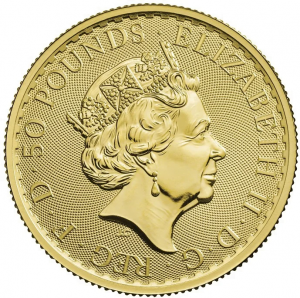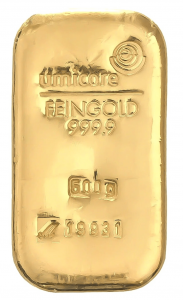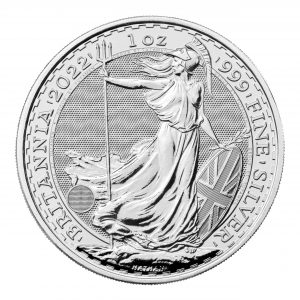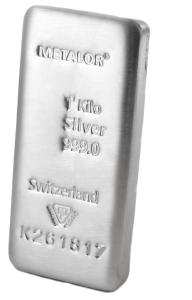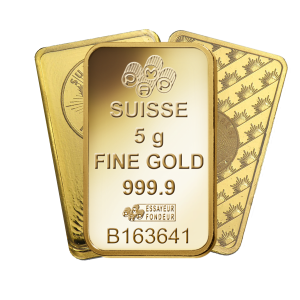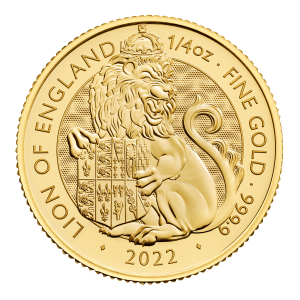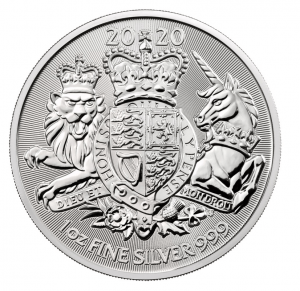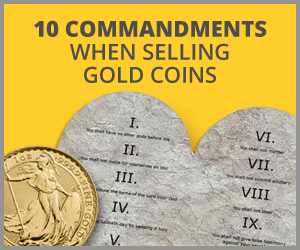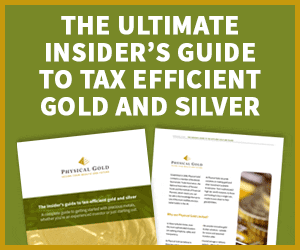Silver is gaining in popularity due to its investment potential that has grown over the years. Due to the rising industrial demand for silver, many investors envision making windfall gains in the future, on the rising price of silver. However, silver has a long history of usage in British coinage and coinage across the world.
Most precious metal investors will insist on finding out the purity of the coin before investing. This may not be entirely true for collectors, who wish to acquire a coin, based on its rarity and numismatic value. However, many collectors have also moved to become investors and want to build a strong portfolio of coins that are both collectable and deliver good value for money. Therefore, in this article, we will explore the purity of silver coins across continents.
The purity of investment-grade coins
Investment coins are as near to pure as possible. Popular bullion coins such as the Britannia are struck to 99.99% purity. None are 100% pure silver. Silver currency coins such as the 50 pence piece are not made from silver at all despite their colour. Their alloy is 75% copper and 25% nickel, a mix known as cupronickel.
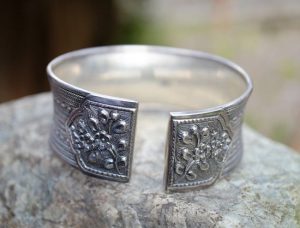
Sterling silver is often used to make jewellery
Similarly, in the United States, most silver coins in circulation contained 90% silver. It was only in 1986, when the American Eagle bullion silver coin was introduced, that the purity of silver was raised to 99.9%, to qualify the coin for investors.
Purity of silver coins across the world
The silver used for coinage in Britain has a minimum purity of 95.8%. Typically, this implies that the silver used for coinage will be an alloy of pure silver, copper and other base metals. The percentage of pure silver in this alloy is 95.84%. Likewise, the alloy would contain 4.16% of copper and other base metals, if any. This standard was developed in Britain as early as 1697. However, we have seen that in recent years, most silver bullion coins minted by the Royal Mint have a purity of 99.9%.
Similarly, France also follows a standard known as the ‘French first standard’. According to this, the alloy contains 95% pure silver and 5% of other base metals, including copper. Russians, on the other hand, use their own standard, known as “91 Zolotnik Russian Silver”. In this, the proportion of pure silver is 94.79%, while 5.21% represents copper and other base metals.
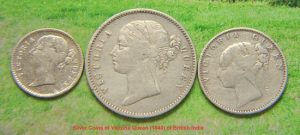
Queen Victoria silver coins from British India
Britain also used “Sterling Silver”, as early as the 12th century. Sterling silver was used for coinage across the British Empire, and many commonwealth countries continued this tradition after the end of colonial rule. Sterling Silver uses 92.5% of pure silver and 7.5% of copper and other non-precious metals.
Other nations may use different standards. For example, Scandinavian silver uses the number 830 to denote its fineness. This simply means that the silver alloy contains 83% pure silver and 17% base metals. In the same way, German silver is denoted with the number 800/835. German silver typically uses 80% to 83.5% of pure silver. However, the term “German silver”, also popularly called nickel silver or alpaca, may contain no silver at all. It is an alloy constructed out of different metals. So, it’s helpful to know and understand these details as an investor, which may help us to ascertain the value of the silver products we are buying.
Talk to our precious metal experts at Physical Gold
At Physical Gold, we have a team of precious metals experts who can advise investors, just like you on making the best investments. Call us today on (020) 7060 9992 or get in touch with us by email regarding your silver investments.
Image Credits: starbright and P.L.Tandon
Over the years, investor interest in silver coins has increased manifold, with the expectation of rich dividends when silver prices skyrocket in the years to come. While gold has been consistent in delivering steady returns to investors, silver has had a more volatile ride. Although silver prices fluctuated in the short term, the high industrial demand for the white metal has ensured healthy interest from investors.
The industrial use of silver
Silver is used in industry, across many applications. As the electronics industry has grown, so has the demand for silver. Silver has certain unique properties like conductivity and ductility that makes it perfect for use in electric cars, computers, mobile phones and solar panels. Most of the components under the hood of these devices use silver extensively.
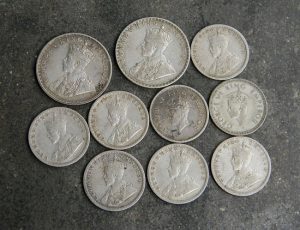
British commonwealth silver coins
Advancing technologies
Due to the advancement of technology in the world, these industries have flourished and are likely to continue growing at an unprecedented pace. Therefore, large volumes of silver will be required to fuel the growth of these industries. However, the production of silver has also dropped over the years. Silver is mined in a select few countries across the world and its production has been continuously falling. The easy inference that one can draw from this situation is that the prices of silver will eventually go up. Silver has also been attractive for precious metal investors since it offers an easy entry into the precious metals market. It is much cheaper than gold and many investors prefer to buy the white metal.
Why buy silver coins?
The two obvious routes for silver investors to take is to buy coins and bars. UK silver coins are preferred by many investors, since they qualify for Capital Gains Tax benefits, as they are considered to be legal tender in the UK. All investment-grade gold is VAT free in the UK, however, in most cases, silver purchases would be subject to VAT. Silver coins are also available in various denominations. Investors who are building a precious metals portfolio will follow their investment objectives, and decide to maximise the liquidity and divisibility of their portfolios. Investing in prestigious silver coins like the silver Britannia, or the silver Maple leaf can increase the value of the portfolio.
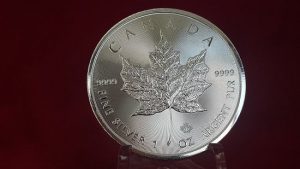
Bullion coins like the Silver Maple Leaf can be bought from reputed dealers
Where can you buy silver coins?
The best place to buy all precious metals is from a reputable dealer. They will likely have a wide choice and stock which can be delivered to you with insured delivery, saving you the time and security of having to pick them up in person. A good dealer will be able to offer guidance and a buyback guarantee. Some silver brokers can sell coins without charging VAT.
Download the Insiders Guide to buying silver and gold here
Reputed silver dealers can be identified by visiting the website of the British Numismatic Trade Association (BNTA). Most reputed dealers are listed on this website, and once you have identified the right ones for you, it’s down to shortlisting them by making contact. If you prefer to invest in silver coins, it is best to identify a good dealer who specialises in this area. Discussing your investment objectives with the dealer may be an excellent idea, as the dealer then becomes aware of what you want from the market and will give you a heads up when the right products become available. When identifying a reputed dealer, always ensure that they provide the certificates of purchase, and have a buyback scheme. Most reputed dealers will also have storage options for you and will deliver your silver purchases through a secure, insured parcel service.
Speak to the silver experts at Physical Gold
At Physical Gold, we pride ourselves on being one of the country’s most reputed silver dealers. We are fully registered with the BNTA and offer free advice to investors on their silver purchases. Please call us today on (020) 7060 9992, or get in touch with us online and a member of our team will contact you very shortly.
Image credits: Wikimedia Commons and Silver Torch 66
The Silver Britannia
The Royal Mint released the silver Britannia in 1997 as the silver counterpart of its flagship coin, the gold Britannia. The initial edition of the silver Britannia contained 1 ounce of silver with a fineness of 95.8%. All the design elements of the original gold Britannia were replicated in the silver version. By 1999, the silver Britannia had a fineness of silver content upgraded to 99.9%, or 999.9. This move by the Royal Mint made the coin attractive to investors and the demand for the silver Britannia soared.
The launch of the silver Britannia was an important event for the Royal Mint and the award-winning designer, Jody Clark was brought in to design the coin. She ensured that the reverse of the coin displayed the iconic image of Britannia, a testament to the bravery and spirit of the inhabitants of the British Isles during Roman times. It is this unmistakable image, coupled with the portrait of our Queen, Elizabeth II on the obverse of the coin, that makes the silver Britannia, a highly collectable and valuable coin for investors.
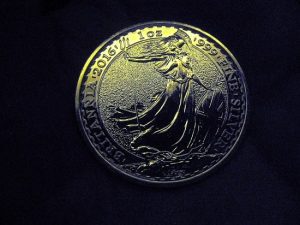
The silver Britannia is a highly collectable coin
The American Eagle
The American Eagle is a silver bullion coin minted by the United States Mint and is now considered to be the official silver bullion coin of the country. The coin was first minted in 1986, which is a year earlier than the release of the gold Britannia by the Royal Mint. Like the silver Britannia, the American Eagle is a 1-ounce silver coin, containing one Troy ounce of silver and a face value of a dollar.
Silver content
The content, weight and purity are certified by the United States Mint and the coin is minted with 24-carat silver, having a purity of 99.9%. Apart from the bullion version, the US Mint also produces a proof version of the coin and an uncirculated version, which is aimed at numismatists and collectors. When we speak about the United States Mint, it does not imply that there is only one manufacturing location, in reality, the American Eagle is usually struck at the Philadelphia Mint, the San Francisco Mint and the Westpoint Mint.
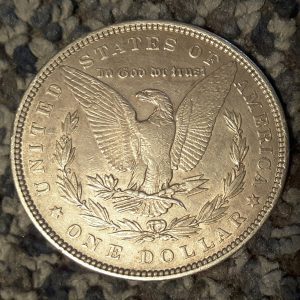
The American Eagle silver coin is available as a bullion coin
Design
The obverse of the American Eagle features a motif called ‘The Walking Liberty’. This theme had been used in previous coins produced by the United States Mint. It also contains the phrase, “In God we trust”, which is visible in many American coins. The reverse of the coin was originally designed by John Mercanti. The reverse portrays an image of a Heraldic Eagle, behind a shield, holding an olive branch. The Great Seal of the United States is also visible above the Eagle, along with 13, five-pointed stars, which represents the colonies.
Comparison of the two coins
Both coins are world-renowned and produced to a number of finishes. The Britannia can be bought slightly cheaper in the UK and has an increased fineness of 999.9 versus the Eagle’s 999.0. Both can be easily sold anywhere in the world. The Britannia is preferred within the UK due to its Capital Gains Tax-free status, whereas the silver Eagle is more popular in the US and Canada.
Talk to Physical Gold for all your silver coin purchases
Physical Gold is one of the country’s most reputed coin dealers and gold and silver merchants. We are registered with the BNTA and our advisors can help you make the right decisions when purchasing silver coins. Call us today on (020) 7060 9992 or drop us an email by visiting the contact page on our website.
Image Credits: Eric Golub and Public Domain Pictures
The silver Britannia is an iconic British coin introduced by the Royal Mint. These are 1oz coins minted by The Royal Mint to a purity of 999.9 silver. They were first issued in 1997, 10 years after the gold 1oz Britannia, and have become a very popular choice for physical silver investors. They can be bought at relatively low prices as they’re minted to bullion standard and large numbers. They have a face value of £2 which means they’re legal tender and therefore any rise in value is free from Capital Gains Tax.
In 1987, the Royal Mint introduced the gold Britannia coin. The coin enjoyed popularity amongst investors and the silver Britannia was introduced into the market to replicate the success of its gold counterpart. Although the coin was upgraded to 24-carat silver with a fineness of 99.9% in 2013, the original issue had a fineness of 95.8%. The Royal Mint wanted to create a replica of the gold Britannia in silver.
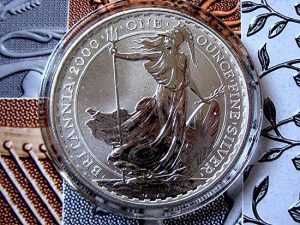
The beautiful Silver Britannia, designed by Jody Clark
The design of the silver Britannia
The silver coin was expected to mirror its gold counterpart in terms of look and feel. So, the well-known coin designer, Jody Clark was commissioned to do the job. The design of the silver Britannia features the image of Britannia, holding her shield and trident. It is now thought that this image originated during Roman times and depicted the spirit and bravery of the British people. The coin portrays the warrior goddess on its reverse and features an image of Queen Elizabeth the second, the longest-reigning British monarch on the coin’s obverse. The upgrade of the fineness of the coin in 2013, increased the demand for the silver Britannia. Importantly, the coin offered investors an avenue to get into the precious metals market at a lower price point than purchasing gold coins.
Advantages of buying the silver Britannia
The bullion version of the coin carries low premiums since the coin was introduced recently. However, commemorative issues and collectable editions of the coin can attract higher premiums. Availability and affordability are the two pillars that have contributed to the popularity of the silver Britannia. In March 2020, the gold-silver ratio touched an astonishing 125:1. Since then, there have been changes to this ratio, but the price difference between the purchase of the gold Britannia and the silver Britannia has encouraged investors to buy this coin.
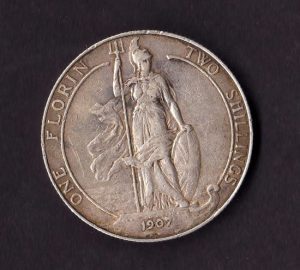
The image of Britannia has been used earlier in British coinage, like this Edward VII Florin
Tax efficiency
In addition to the advantages offered by the low price of silver, when compared to gold, the silver Britannia is a legal tender coin. In the UK, this means investors can book profits on the sale of this coin, without having to pay Capital Gains Tax (CGT). This exemption can ensure tax-free profits within a single tax year for many investors. The silver Britannia is an excellent coin to purchase, due to its advantages as a tax haven.
Download the 7 Crucial Considerations before you buy Silver and Gold. Click here.
Divisibility and liquidity
The silver Britannia is an extremely popular and liquid coin across the world. This ensures that investors can book profits by selling the coins at any given point in time. The coin is also available in different weights and sizes. So, an investor can benefit from the variety and divisibility that the silver Britannia has to offer.
Contact Physical Gold for the best deals on silver Britannia coins
We are one of the best gold and silver dealers in the UK, with an impeccable reputation. Our investment advisory team are always happy to answer your questions on buying silver coins. Please call us on (020) 7060 9992. Alternatively, you can also get in touch with us online by visiting our website and sending our team an email.
Image Credits: Eric Golub and Smabs Sputzer
Investors have shown a healthy interest in purchasing silver coins over the last few years. One of the factors for investors who opt to invest in silver is simply the gold-silver ratio. Silver is a lot cheaper than gold, allowing investors who are starting to enter the precious metals market and buy the white metal.
Investors can also expect capital appreciation on silver investments, due to the rising demand and falling supplies of the white metal. Of course, buying physical silver, like any other precious metal is devoid of counterparty risks, as the owner holds the asset in its physical form. Silver coins are a better investment for many investors, as their legal tender status in the country circumvents the need to pay Capital Gains Tax (CGT). Of all the silver coins in the market, possibly the best investment option is the silver Britannia.
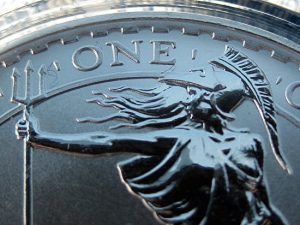
A close-up of the intricate design elements of the Silver Britannia
History of the coin
The coin was introduced in 1997, ten years later than its gold counterpart – the gold Britannia. Since its release, the coin has been minted in different dimensions and has enjoyed immense popularity amongst investors. Although the silver market is fairly volatile, it is lucrative for investors to purchase this coin at current prices, and book profits in later years, once the spot price of silver rises. The low price of silver, when compared to gold is only one of the factors that have spurred investors to buy the silver Britannia. The intricate design of the coin is very attractive and features the iconic image of Britannia, with the shield and trident on the coin. The other side of the coin features the image of our reigning Queen, Elizabeth II.
How to buy the silver Britannia?
They are best purchased through a professional precious metals broker. Reputable dealers can be found on bnta.net. Most will offer discounts for quantity purchases, so it’s best to buy in one go to achieve the best discounts, rather than little and often. Certain online portals are structured to deliver them without the need to charge VAT, saving a further 20%.
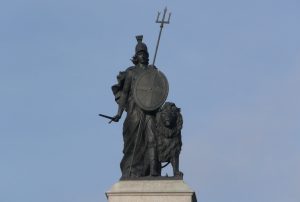
The iconic image of Britannia depicted here in a statue
When identifying a reputed dealer, it is important to assess the company’s market reputation and the years in business. The best precious metal dealers in the country have a formidable track record of being in business for many years and will display good customer testimonials. All of this can be verified online. Most reputed dealers are registered with the British Numismatic Trade Association (BNTA). If you visit their website, you can access a full list of registered dealers in the UK. From here on, the best strategy is to build a relationship with the dealer. If you let the dealer know that you are keen to invest in silver Britannia coins, their team can advise you on the best deals available in the market. Discussing your investment objectives with the dealer can also be helpful, as they can guide you to the best deals available.
Tax considerations
The silver Britannia is considered to be legal tender in the UK. This means the coin has a face value and it qualifies for Capital Gains Tax exemption. So, the silver Britannia can be an excellent addition to your precious metals portfolio.
Get in touch with us for all your silver investments
Physical Gold is one of the U.K.’s most reputed precious metals dealers and is registered with the BNTA. We have a great team of investment advisors who can guide you, and help you acquire the best deals on silver Britannia coins. Call us today on (020) 7060 9992 or drop us a line, so we can get in touch with you and discuss your investment plans.
Image credits: Eric Golub and Glamhag
The Britannia is one of the most famous coins ever released in British coinage history. It is the pride and joy of the Royal Mint and also forms the backbone of any precious metal coin portfolio. The Britannia is available in both gold and silver and offers tremendous liquidity to the portfolio of an investor. Due to its reputation as one of the best-known coins in the world, it is easily saleable for cash.
The Britannia coin
The Britannia gold coin is a 1-ounce coin with a purity of 999.9 and a face value of 100 GBP that was launched by the Royal Mint in 1987. It is available in bullion and proof finishes, as well as fractional sizes. The Royal Mint also introduced a silver Britannia coin in 1997, which has a face value of 2 pounds. The silver Britannia contains one Troy ounce of fine silver. Both the gold and the silver coin feature a portrait of the reigning British monarch, Queen, Elizabeth II on the obverse of the coin. The reverse of the coin features the classic image of Britannia. The event featured on the coins issued from 1987, was designed by Philip Nathan. In 2018, the Royal Mint also released a Platinum version of the Britannia coin that contains one Troy ounce of Platinum and has a face value of £100.
The iconic image of Britannia above Somerset House in London
Who was Britannia?
In 43AD Britannia meant Roman Britain. This was an area to the south of what is known today as Scotland. In 197AD Roman Britain was divided into 4 provinces and 2 of these were Britannia Superior and Britannia Inferior. Britannia was the name given to this Island. In the 2nd Century, Roman Britannia was what is recognised today as the goddess armed with a trident and shield. Britannia was featured on all modern British coinage until being redesigned in 2008.
The Romans used the term ‘Britannicae’ to refer to the British Isles. The inhabitants of Britain were called ‘Britons’ at the time. Another name for the people of the British Isles used by the Romans was ‘Britanni’. Since the British Isles represented the furthest territory of the Roman Empire, it became symbolised with the goddess of warfare and water. Roman mythology portrays a goddess called Minerva, who is popularly known as the torchbearer of arts, commerce, strategy and wisdom. The image of Britannia was based on the icon of goddess Minerva and came to personify the British Isles over the years.
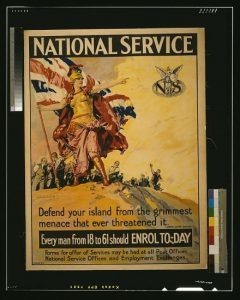
A World War 1 Poster depicting Britannia
Reinforcement of the Britannia image
After the invasion of England by the Anglo-Saxons, the ethnicity of the country changed drastically, with the exodus of the original Celtic Britons. However, years later, as Queen Elizabeth, I combined England, Scotland, Ireland. and Wales and significantly increased the nation’s naval power, the image of Britannia was restored as a representation of the nation’s power and the Queen. This was further reinforced during the reign of the great Queen Victoria when the British Empire became the most powerful empire in the world and Britannia ruled the waves. The iconic image of Britannia was then put firmly in place to represent the power of the British Empire, and its monarch.
Physical Gold can assist you in purchasing Britannia coins
Whether it’s gold Britannias or silver ones that you’re after, our coin experts at Physical Gold can advise you on how to get the best deals. Call us on (020) 7060 9992 or drop us an email and a member of our team will reach out to you at the earliest.
Image credits: Alastair Rae and Picryl
The dictionary meaning of the word “GROAT” denotes a silver coin that was used in the 14th century across England and Scotland. The word ‘Groat’ is derived from an old French word – Gros, which meant great, or big. There is also a Dutch word – Grootpennig, which meant a big penny. Thus, the word may have been derived from either of these origins.
There is, however, another dictionary meaning of the word ‘Groat’. This refers to the seeds of grains such as oats, rye or wheat. Once the outer shell of the seat is removed, it can be cooked. However, this has nothing to do with coinage or the silver coin, in particular.
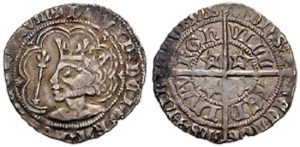
Groat coin from Scotland 1367
History of the groat coin
The Groat coin had a value of 4 pence. The French had a similar coin, which they called ‘Gros Tournois’. It is possible that the silver coin used in England and Ireland originated from this. There was a separate Scottish coin with the same name, which initially had a value of 4 pence, but was later minted as an 8 pence coin. There was also a Scottish version where the coin was worth a shilling.
The coin was initially circulated by Edward I around the year 1280. The coin became popular and enjoyed circulation in England for the next two centuries as the largest silver coin at the time. Eventually, its place was taken by other large coins such as the Shilling introduced by King Henry VII. The coin continued to be minted until the last one, which was made in 1855.
However, mintage was stopped during certain periods. For example, King James I, whose reign was between the years 1603 to 1625, withdrew the mintage. There was also a lull in mintage from 1649 to 1660. These years are better known as the Commonwealth period. However, the Groat was issued as a proof coin twice between 1857 and 1862. In 1888, there was a colonial issue of the coin. Interestingly, the Groat has become a part of The Maundy Set, issued on Maundy Thursday every year by the Queen.
The silver content of the Groat coin
Over the years, the silver content of the coin was slowly reduced. The first English Groat contained 5.8 g of silver. During the reign of Edward III, this fell to 4.7 g and continued to become much less going forward. The Groat issued by King Henry IV had only 3.9 g of silver, which was further reduced to 3.1 g by King Edward IV. It reached 2.1 g by 1559, by which time the purity of the silver contained in the coin had also fallen. After 1561, the coin was withdrawn from circulation for the next hundred years.
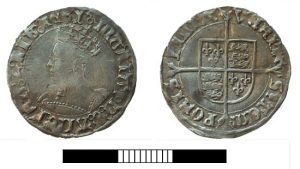
Groat coin found in Oxfordshire
Mintage in later years
Groats were minted only a few times during later years. By this time, it had come to be known as a 4 pence coin. There were a few years mintage after 1786, these years being 1792, 1795 and 1800. The colonial Groat that we discussed earlier, was minted in 1888.
This colonial issue was intended for the countries of British Guyana and the British West Indies, both of which were part of the British Empire at the time. The British Guyana version remained in circulation up to 1955.
Want to find out more about historical coins? Call Physical Gold
Physical Gold is one of the nation’s most reputed precious metal dealers. Our coin experts are best placed to guide you on the purchase of rare and historical coins. If you have such a coin in your possession, it is best to speak to a member of our team for its evaluation. Call us on (020) 7060 9992 or get in touch with us via our website.
Image credits: Wikimedia Commons and Wikimedia Commons
Dieu et Mon Droit – How did the phrase originate?
The origin of the phrase goes back to the time of Richard I, who was descended from French ancestry. King Richard was the King of England from 1189 till his demise in 1199. King Richard used this phrase to announce that it is the divine right of the King, or Monarch to govern.
The phrase was later adopted by King Henry V, as the Royal motto for the Kingdom of England. The phrase now appears on the coat of arms used by the British monarchy. People often wonder how a French phrase could be adopted by the English Royal Family. However, mediaeval England was not the same place that we know now. Norman-French was the language of the English Royal Court at the time. The rulers and the upper classes also spoke this language during that period.
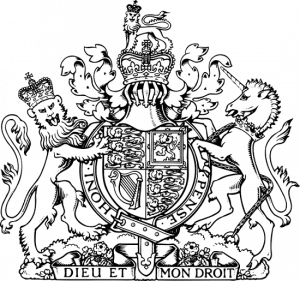
The Royal Coat of Arms
The meaning of the phrase on the coat of arms
When translated, the phrase simply means “God and my right”. Currently, it is the motto of the British Royal Family. A close inspection of the coat of arms used by the British Monarch, reveals that the inscription can be found on a small banner underneath the shield. In the present day, the coat of arms is used by our reigning monarch, Queen Elizabeth II. On the left of the shield, stands the guardian lion wearing the crown of St. Edward. On the right of the shield is a Scottish Unicom. Underneath the shield, there is greenery, with a thistle, Tudor rose and Shamrock. These are representative of the kingdoms of Scotland, England and Ireland. Right below this display is a banner containing the words “Dieu et Mon Droit”.
Where can this coat of arms be seen?
The coat of arms is the official symbol of the British Queen. Therefore, it is clearly visible in every UK court of law, except for the Supreme Court of the United Kingdom and the Magistrate’s Court in the City of London. It is also used on government documents and you might be able to view it on your passport. Globally, this coat of arms is visible on the entrances to UK embassies and consulates.
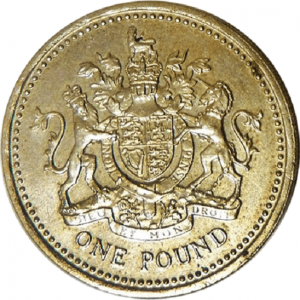
1983 one-pound coin
Appearance on coins
The royal coat of arms has been featured regularly on British coinage, manufactured by the Royal Mint. The most common example of this is the British one pound coin, which has been in circulation since 1983.
By 2008, the Royal Mint had minted a new series of coins with a denomination of 1 pound and below. The full Royal coat of arms appears on the one pound coin with the phrase Dieu et Mon Droit. However, only sections of the coat of arms can be seen on the coins of lower denomination. In 2016, the Royal Mint released a new bimetallic coin called the nations of the crown. Interestingly, an old British coin called the Guinea, which was minted between the years 1663 and 1814 also displayed the royal coat of arms, with the inscription. The coin took its name from the West African nation, Guinea. The gold that was used to mint this coin was sourced from here.
The numismatic experts at Physical Gold can address all your queries related to coins
Collecting coins can be an absorbing hobby, and if the coins are produced from precious metals, they can add tremendous value to your collection. Many collectors and investors have questions related to precious metal coins. Call our coin experts on (020) 7060 9992 or reach out to us via our website and we will be happy to advise you on all your coin purchases.
Image credits: Wikimedia Commons and Wikimedia Commons
Investing in gold and silver coins can be an absorbing passion, as well as a lucrative hobby that allows you to reap rich rewards when you make the right investments. However, when you purchase gold and silver coins, it is extremely important to carry out your transactions through a reputed dealer.
Problems you may face when you buy from a high-street dealer
Buying a precious metal coin is all about ascertaining its authenticity. If you are a layperson, or a hobbyist, the chances are that you may be easily taken for a ride by a pawnbroker or high-street gold dealer. There are several factors to consider. Firstly, you need to be sure about the authenticity of the coin. Next, you should also be able to identify the purity of the metal used to manufacture the coin.
To do this, you will require certain testing equipment. In the absence of proper identification and purity assessment of the coin, you run the risk of being cheated. Additionally, a high-street gold dealer would not have a vast inventory of coins to choose from. More importantly, when you leave the premises of the high-street dealer with your valuable purchases, there is a good chance that you can be targeted for robbery.
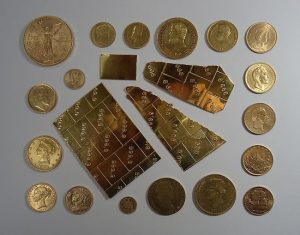
Fine gold and gold coins
Identifying a reputed dealer
If you search on Google for “coin dealers near me”, you will come up with a list of coin dealers based on the geographical area, you are located in. Cross-referencing the list with a reputed industry body like the BNTA can be a great start. The BNTA website publishes a list of affiliated, reputed coin dealers. The first thing you can do on shortlisting these dealers is to give them a call.
A reputed dealer will always answer all your questions openly. No information will be kept hidden from you. Also, you will find that most reputed dealers have a large online catalogue that you can browse through when making a purchase. Lastly, they would offer a buyback guarantee. Needless to say, if a dealer refuses to buy back the gold, they are selling to you, there must be something wrong.
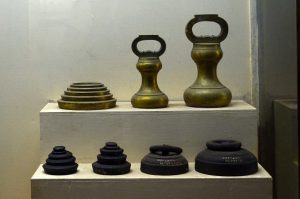
Gold measurement tools from yesteryear
Building a relationship
In order to acquire the best deals on coins, you need to build a steady relationship with the dealer. You need to discuss your buying preferences, specific coins that you are looking for, and a ballpark price that you are willing to pay for them. This will give the coin dealer a good idea of what you’re looking for. So, when an opportunity to purchase a good coin comes up, you’ll be the first to know. It is a mistake to think that the term “coin dealers near me”, simply means that you are limited to small pawnshops, antique vendors, and the like
A reputed online merchant would be able to fulfil your requirements since most of them have a countrywide distribution facility. You would be required to insure your purchases and pay for any shipping logistics. However, this ultimately ensures your safety, and the goods will be securely delivered to your residence.
How a reputed dealer can add additional value
Investing in precious metal coins is also about maintaining divisibility, liquidity, and tax efficiency within your portfolio. Gold coins are free from VAT in the UK and may also be exempt from capital gains tax. A good dealer will be able to advise you on how to create variety in your portfolio while ensuring that liquidity and divisibility are maintained.
Discuss your coin purchases with Physical Gold
At Physical Gold, we take pride in being one of the nation’s most reputed online dealers. Our advisors are always at hand to assist you in your coin purchases. Call us today on (020) 7060 9992 or contact us online via our website.
Image credits: Wikimedia Commons and Wikimedia Commons
British coinage is considered to have one of the richest histories, compared to any nation globally. Our long tradition of Kings and Queens has resulted in one of the world’s oldest coinage systems that have witnessed the reigns of several monarchs over centuries. When we study European coinage, Britain’s history is distinctive and different from the coinage of other European kingdoms and monarchies.
During the 19th century, there were approximately 20 ruling monarchies across Europe. Of course, the currency coins released by many of these monarchs featured a stylised image of the ruler and motif or a coat of arms on the other side of the coin. Now, British coins have had certain peculiarities in the past. These usually consisted of a slogan or a line embossed on the coin. However, who would’ve thought that the German words ‘ich dien’ could appear on a British coin?
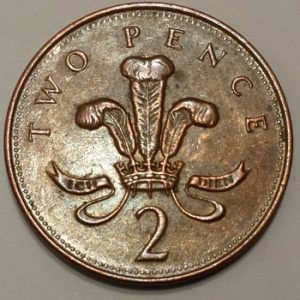
Two pence coin bearing the inscription – ‘ich dien’
What does ‘ich dien’ mean?
Well, the words ‘ich dien’ in the German language literally means ‘I serve’. These words appear on the coat of arms of the Prince of Wales. The words appeared as early as the 14th century, leading to several speculations regarding the origins of the phrase. Interestingly, these words have also been used by Edward the Black Prince. The phrase may have been adopted following an alliance or a meeting with a German monarch, but history has no record of any such event. Therefore, we may never know the exact reason why the phrase ‘ich dien’ was adopted.
The feathers of the Prince of Wales
It is customary for many royal houses to have an insignia or a coat of arms. This creates an identity that can be instantly recognised, much like a logo on a product. The Prince of Wales uses a heraldic badge as the royal emblem. The words ‘ich dien’ is imprinted on the bottom of this badge. However, the phrase was not used only on the emblem. The words ‘ich dien’ can be found imprinted on certain British coins over the years.
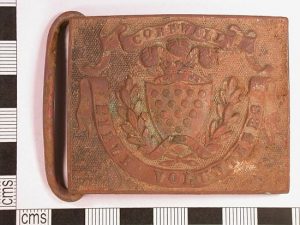
1870 belt plate from Cornwall with the inscription – ‘ich dien’
British coins that carry the words ‘ich dien’
The most commonly found ‘ich dien’ coin is the two pence coin. The words appear on the reverse of the coins of this denomination that were issued between the years 1971 and 2008. Of course, this was not so long ago, and so many such coins can be found in circulation even today. You may have one in your pocket right now!
2008 proof coin celebrating the birthday of Prince Charles
In 2008, his Majesty the Prince of Wales celebrated his 60th birthday. To commemorate this important occasion, a proof coin was minted and released by the Royal Mint. This coin has the words ‘ich dien’ embossed directly on the face of the coin, underneath a stylised image of Prince Charles. This proof coin is of interest to numismatists due to its uniqueness.
Other British coins containing the phrase ‘ich dien’
While the above are examples of recent British coins that contain the German phrase, many other notable coins do so too. The 1811 one penny “Bristol and South Wales” Coin also carries the Prince of Wales’s feathers and the inscription ‘ich dien’. Similarly, there is a British India medal, although officially not a coin in circulation, it carries the words, ‘ich dien’. This medal commemorates the royal visit of King George the fifth to India.
Talk to the coin experts at Physical Gold
Our coin experts are extremely knowledgeable about collectable coins as well as bullion coins. Whether you’re an investor or a collector, you can benefit by giving us a call on (020) 7060 9992. You can also send us an email and we will get in touch with you at the earliest.
Image credits: Wikimedia Commons and Wikimedia Commons

